 |
||
|
||
| ||
 Look at the fruit of working of the SUMA designers. 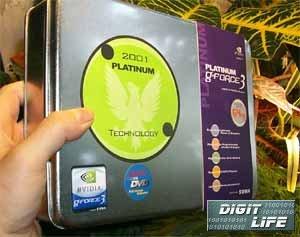 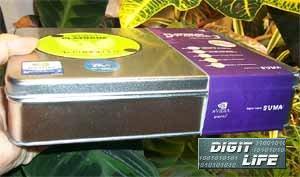 What's this? SUMA decided to please people who made their mind to spend such a heap of money for their product with delicious... (Let me open the box): 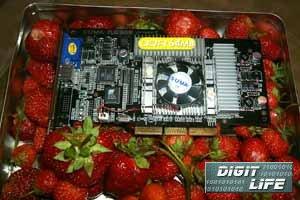 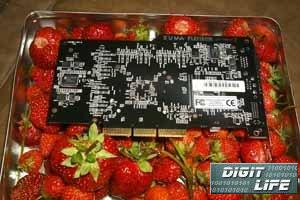 ...berries (not sweets). It's very pleasant to see such a surprise, isn't it? Strawberries turned to be very fresh. And how the company hid the User Manual and CDs will remain a secret :-) Initially, the video card was located in the box under the strawberries (we have taken it out purposely). 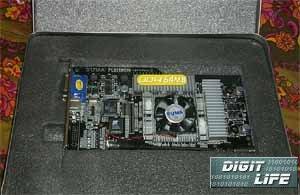 The card sits roughly in its place made of foam-rubber; if you lift it, you can see the rest of the components on the bottom of the box:  The card ships in a Retail package together with:
Before examining the card in question I should draw your attention to the following articles where you can find the whole theoretical base connected with this GPU:
Today we will examine the NVIDIA GeForce3 in the 3DMark2000, whose game scenes are still topical. Now let me show what peculiarities the SUMA Platinum GeForce3 has. CardThe SUMA Platinum GeForce3 has AGP x2/x4 interface, 64 MBytes DDR SDRAM memory located in 8 chips on the right side of the PCB.  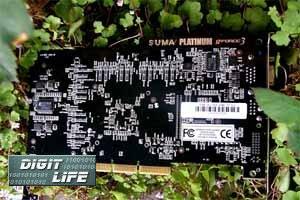 EliteMT produces memory chips with 3.8 ns access time, which corresponds to 260 (520) MHz. Like all other GPU GeForce3 cards, the SUMA Platinum GeForce3 works at 200/230 (460) MHz. Unfortunately, I can't show you a photo of the memory modules since the chips are covered with rigidly sitting heat sinks. The card's design follows the reference one from NVIDIA, which we have already seen on earlier examined models on this GPU. The design of a system cooling the GPU corresponds to the style of SUMA, i.e. the chipset is covered with a large silvery heat sink with an efficient fan in the center. The PCB is traditionally black. The TV-out is installed on the card, but the DVI-interface is not unsoldered. OverclockingThe SUMA Platinum GeForce3 could reach only 230/265 (530) MHz. It is not a record among all earlier examined cards on the GeForce3. But overclocking depends on a definite sample. It should be noted also that additional cooling must be provided during overclocking of the system. Installation and driversTest system configuration:
For testing we used drivers from NVIDIA of 12.90 version, VSync was off. For comparative analyses the results of the following cards are given:
The card is supplied together with NVIDIA drivers v12.41, settings of which allow for adjusting the majority of necessary functions. But for advanced users I would recommend to enable some more functions with the RivaTuner by Aleksei Nikolaychuk, which I have written about in the ASUS AGP-V8200 Deluxe review. In particular, it helps to enable anisotropic filtering. Test resultsThe SUMA Platinum GeForce3 has excellent 2D quality. I.e. in 1600X1200 resolution at 75 and even 85 Hz one can work comfortably with a large monitor. For estimation of 3D quality we used MadOnion 3DMark2000 v.1.1 - a synthetic test showing how the card works in the Direct3D when the graphics is very complex. Why this test? The matter is that the level of modern games is not sufficient to buy a super expensive accelerator for middle-level 3D graphics. The 3DMark2001 test shows the graphics of tomorrow, i.e. of the period of the end of 2001 - beginning of 2002. The most powerful GeForce3 doesn't perform well in some subtests of the 3DMark2001. Some time ago we could witness the same situation with the 3DMark2000, when modern 3D accelerators coped with the tests with great difficulty. Today there are several games on the market which can compete in complexity with game tests from 3DMark2000. That is why it is very interesting to test now the most powerful cards with a one-year-old packet which was created with some reserve. 3DMark2000Game1 - low-detail levelThe Game1 is a game test made as a war air simulator. The Low mode deals with 4 sources of light, the scene uses 6997 polygons, the texture size is 2.74 MBytes. 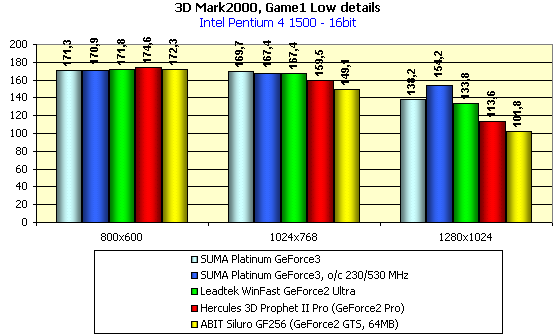 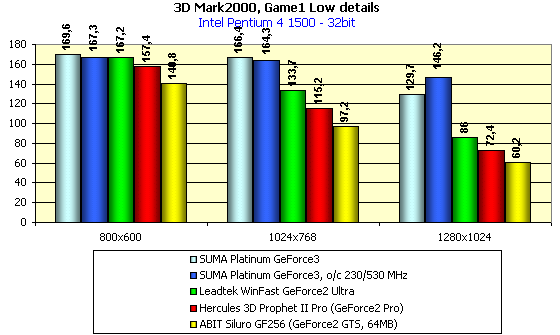 It is well seen that in 16-bit color everything is limited by the processor's frequency, and only at 1280X1024 not only the card yields fruit but so does the overclocking. The 32-bit color stresses all advantages of the GeForce3. Exactly a year ago video cards on the GeForce2 GTS (with 32 MBytes memory) cost almost the same as today's GeForce3 cards. At the same time the performance grows more than twice at high resolutions (1280X1024). Game1 - medium-detail levelIn the Medium mode there are 5 sources of light, 13520 polygons, 2.87 MBytes of textures. 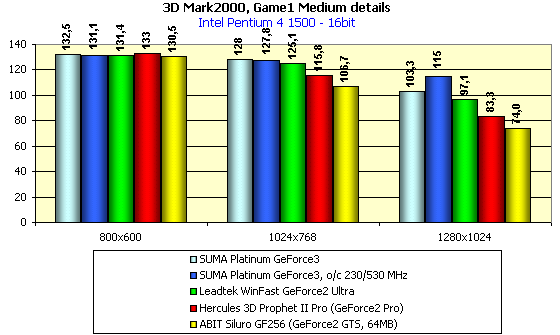 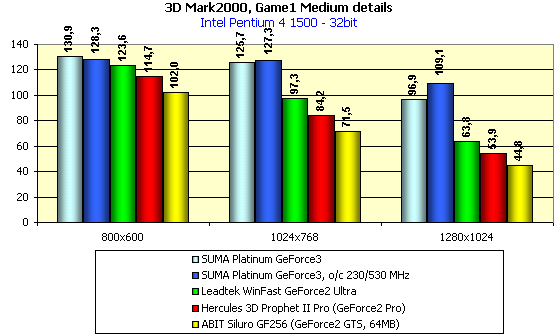 The situation is very similar to the previous test. In the twice complex scene the ratio of the performance of the video cards hasn't almost changed. Game1 - high-detail levelIn the High mode we have 5 sources of light, the scene complexity makes 53026 polygons, the texture size is 2.81 MBytes. 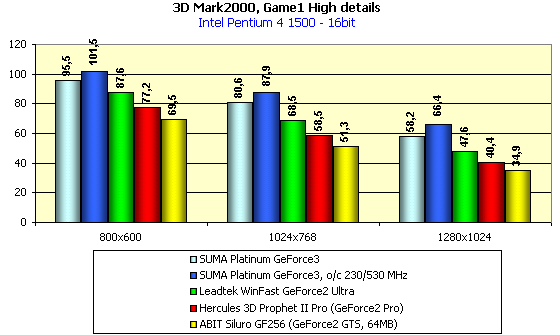 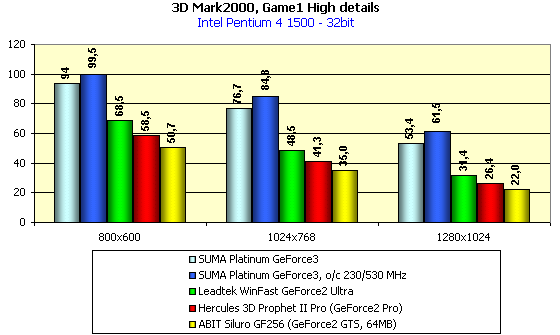 Such a sharp increase in the scene complexity made the proportion change with the general fall in the performance. Look, the GeForce3 is nearly twice ahead of the GeForce2 Pro! Of course, we mean the 32-bit color. But the modest texture size looks like a disbalance, for example, in the Giants the scene complexity can reach the same level, with the texture volume being great. Game2 - low-detail levelThe Game2 is a game test of the Adventure type. In the Low mode there are 5 sources of light, 9392 polygons and 3.14 MBytes texture size. 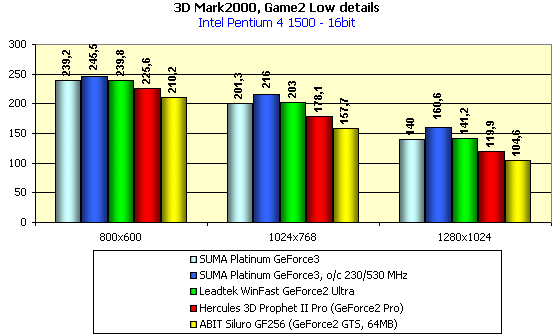 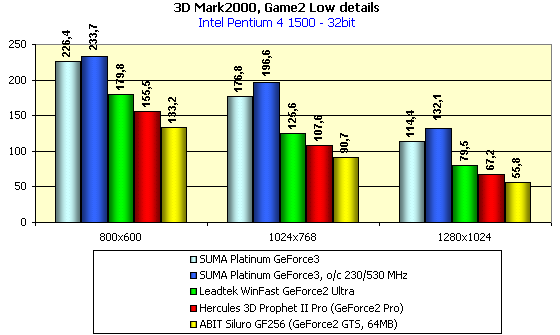 In this scene at the minimal detailing moving objects are absent, that is why we witness such high FPS. A higher frequency of the GeForce2 Ultra helped the latter in 16-bit color to outscore the GeForce3. But on the whole the situation is similar to the previous one. Game2 - medium-detail levelIn the Medium mode we have 7 sources of light, 17084 polygons, 3.31 MBytes texture size. 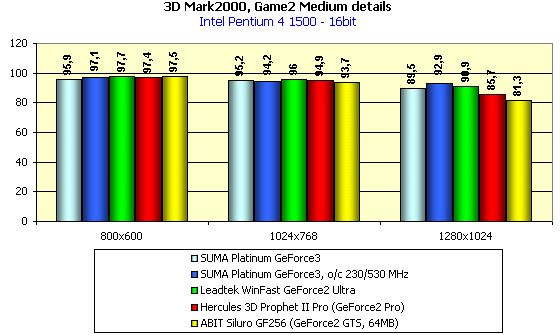 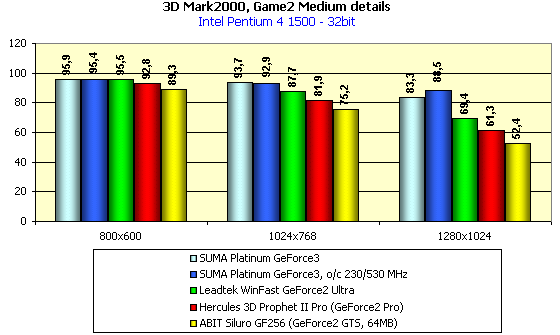 Look how strong the proportions change. In 16-bit color everyone performs excellently, but it isn't surprising. The number of sources has increased, and the performance is now limited by the Hardware TCL unit. The increase in the scene complexity didn't allow the faster GeForce2 Ultra take the lead, but in all processors of the GeForce class the performance of the Hardware TCL unit depends completely on the GPU frequency. The new feature of the GeForce3 (shaders) is not enabled in the 3DMark2000. Game2 - high-detail levelIn the High mode we have 8 sources of light, 29941 polygons in the scene, 3.41 MBytes texture size. 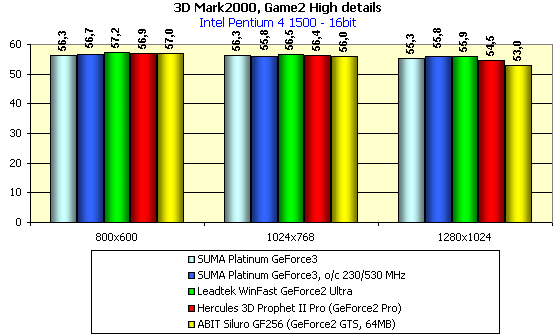 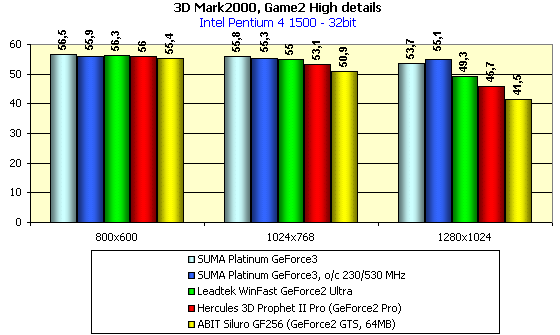 This test confirms the conclusions of the previous one. The number of sources hasn't yet increased, but the GeForce3 loses its leadership in 16-bit color because its T&L unit works at 200 MHz against 250 MHz of the GeForce2 Ultra. Look, while in the Game1 in the high-detail mode and with a very complex scene (more than 50,000 polygons) the GeForce3 almost twice ahead of its a-year-old competitors, in this tests, when the scene is much less complex, its leadership is lost. In fact, the GeForce3 has the same geometrical coprocessor as the GeForce2 GTS/Pro, without taking into account unrealized programmability of this T&L unit. Anisotropic filtering in Direct3DUnfortunately, while in the OpenGL the drivers allow forcing 3 levels of anisotropy (Level 2,4,8), in the Direct3D there is only one level (Level 2). But what "level" means in the anisotropic filtering? In the bilinear filtering the color of a pixel is defined by mixing of values of 4 pixels on a texture (these values mixed two by two according to linear dependences, and then the results are mixed with each other, that is why it is a BIlinear filtering). In case of the trilinear filtering the values of two colors of pixels on the neighbor MIP-levels achieved after the bilinear filtering are mixed with each other (hence TRIlinear filtering). But this type of filtering is some kind of additional to the bilinear filtering and eliminate side artifacts of the MIP-mapping. The anisotropic filtering is some kind of quality development of the bilinear one, and its aim is to give a sharper image reacting upon the change of a line of sight of a gamer relatively to objects in a 3D scene. In other words, the bilinear filtering doesn't account for the fact that in 99% of cases we see textures inclined at different angles, not necessary at 90 degrees. 4 samples are not enough to account for these inclines, that is why the color is formed after a complex sampling operation of 8 - 32 samples on a texture. As a rule, the anisotropy is realized in an adaptive form, when the number of samples for sampling operation is not strictly established. It floats within the given range depending on a scene or a game. Supposedly, the drivers set only the upper limit of this number. Why supposedly? Because the driver sets only the level of anisotropic filtering which has nothing to do with the number of sampling of texture samples. Nobody can say definitely what is Level, since it is a secret of GPU developers. It is possible that Level of the anisotropy can mean different. I have found the information on the Internet that it is a ratio of the length to the width of the sampling (or a ratio of two diameters of a sampling of an elliptic form), but exact data are absent. Why does the number of texture samples depends on the driver settings for the Level? Well, at least because at different Levels the performance drop is different, as well as the quality of anisotropy. While you may argue against the latter, the performance drop says that the size of sampling is different at different Levels. But I don't see any regularity in the connection between the Levels and the number of texture samples for forming of anisotropy. In the Direct3D there is only one degree of this filtering - Level 2. We assume that the sampling size doesn't exceed 8 texture samples. But it is only an assumption. The effect of the anisotropic filtering can be seen in the Unreal Tournament (Direct3D): Anisotropic filtering enabled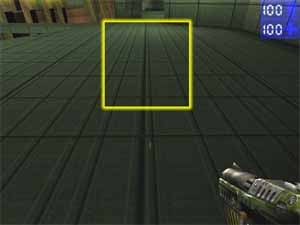 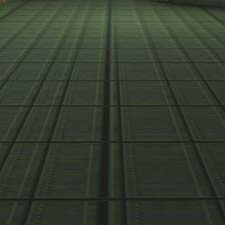 Anisotropic filtering disabled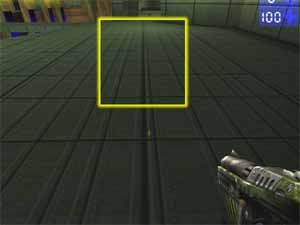 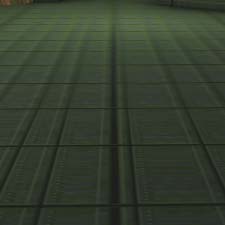 Even at such a small degree of anisotropic filtering the effect is vivid. Now let's look what's the fee for such beauty. 3DMark2000, activation of anisotropic filteringGame1 - low-detail level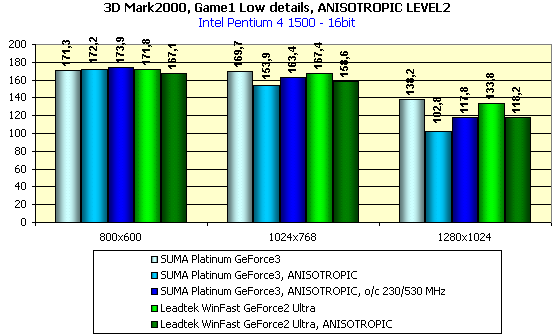 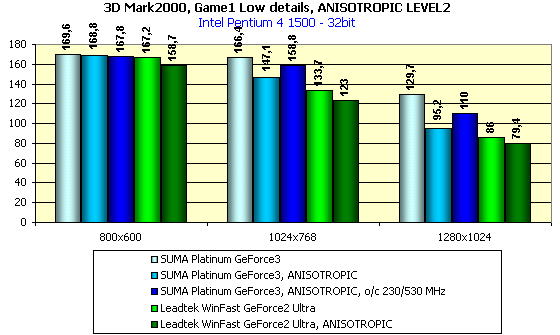 Game2 - low-detail level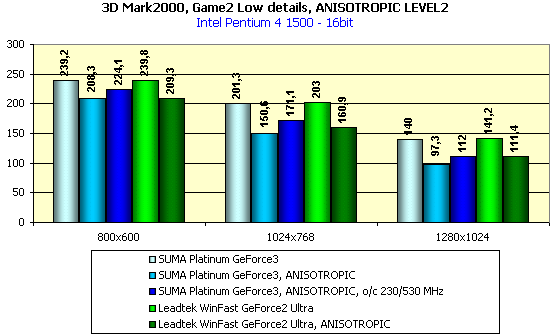 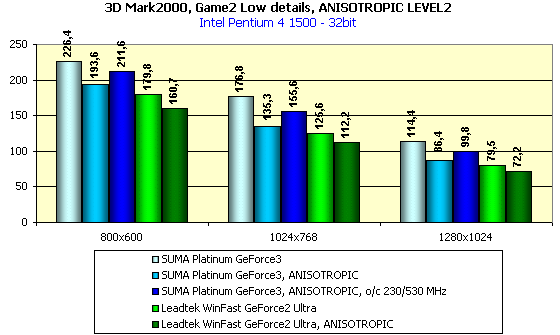 Since the GeForce3 is a well balanced accelerator, an extra load at the additional calculation of anisotropy results in a considerable performance drop. The GeForce2 GPU doesn't have it because the chipset speed is always limited by the video memory bandwidth, and the processor sometimes stands idle waiting for data from the memory. That is why it isn't so difficult for this GPU to make additional sampling calculations. This analyses stems from the complex examination of peculiarities of the NVIDIA GeForce3; by the example of the SUMA Platinum GeForce3 we had one more opportunity to study some more aspects of operation of video cards based on the high-end accelerator. The 3DMark2000 tests showed excellent playability of such video cards. Additional functionsThe TV-out of the SUMA Platinum GeForce3 is based on the typical processor BT868. The maximum resolution when an image is displayed on a TV screen is 800X600 at 60 Hz. There can be some problems, though, when displaying it through the RCA (probably it is the adapter to blame (not the drivers), since the realization of the TV-out through S-Video is excellent). The problems consists in unstable connection (sometimes drivers do catch a signal on the TV, sometimes don't). I hope SUMA will correct this error. ConclusionWe have examined one more video card on the most powerful graphics processor NVIDIA GeForce3. The SUMA Platinum GeForce3 showed the excellent quality and performance for this 3D-accelerator. The development of the card according to the reference design, equipment with high-quality cooling devices for the chip and the memory provides excellent reliability and stability. Besides, the product is implemented perfectly from the standpoint of assembling, soldering, logic etc. And the card has a very good design and a nice Retail package. Of course, the prices for such video cards are still too high, but they are constantly decreasing, sometimes $30 a week. Among old famous companies we can witness toady newly appeared ones which try to attract attention with the price and unusual packages. The SUMA Platinum GeForce3 can be a good choice among all 3D accelerators of the high-end class. It should be noted, however, that such cards require a processor working at least at 1 GHz, otherwise, it can cut the potential of the card at the popular resolution of 1024X768 very much. The complete characteristics of video cards of this and other classes can be find in our 3Digest. Highs:
Lows:
P.S.The strawberry shown on the photos is just a little
joke :-), but the tin is a real package of the product from SUMA.
Write a comment below. No registration needed!
|
Platform · Video · Multimedia · Mobile · Other || About us & Privacy policy · Twitter · Facebook Copyright © Byrds Research & Publishing, Ltd., 1997–2011. All rights reserved. |